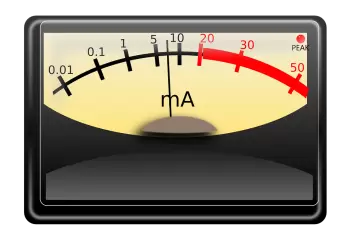
The ampere is the basic unit of current intensity in the international system of units (SI) and is expressed with the symbol (A). Its magnitude corresponds to the amount of electric charge that passes through a section of an electrical conductor.
This unit of measurement takes its name from the French physicist André-Marie Ampère (1775-1836), one of the leading scholars of electromagnetism.
Being one of the seven basic SI units, all other electromagnetic units are derived from it.
To measure current intensity, a device called an ammeter is used.
Definition of ampere
One ampere (A) is defined as the constant electric current which, if maintained in two infinitely long parallel conductors of negligible cross section, separated from each other in a vacuum at a distance of one meter, would produce a force of 2 × 10⁻ ⁷ newtons per meter of length between the conductors.
In other words, this definition is based on Ampère's law and establishes that an ampere is the electric current that, when flowing through two parallel conductors one meter apart, would generate a specific force between them.
This definition directly connects electric current with a fundamental quantity in physics, the elementary electric charge, which is the charge of an electron or proton.
Alternative units
 Although the ampere (A) is the primary unit for measuring electric current in the International System of Units (SI), alternative units are sometimes used to describe electric current in specific contexts or in different systems of units.
Although the ampere (A) is the primary unit for measuring electric current in the International System of Units (SI), alternative units are sometimes used to describe electric current in specific contexts or in different systems of units.
Some of these alternative units include:
- Milliampere (mA) : The milliampere is a unit that is equivalent to one thousandth of an ampere (1 A = 1000 mA). It is commonly used to express small electrical currents, such as those found in low-power electronics.
- Microampere (µA) : The microampere is a unit that is equivalent to one millionth of an ampere (1 A = 1,000,000 µA). It is used to describe extremely small electrical currents, such as those present in some sensors and medical devices.
- Kiloampere (kA) : The kiloampere is a unit that is equivalent to one thousand amperes (1 kA = 1000 A). Although less common, it is used in high power applications and to describe large electrical currents.
- Coulombs per second (C/s) : Coulomb per second refers to the amount of electrical charge (coulombs) that flows through a conductor per second. One ampere is equal to one coulomb per second (1 A = 1 C/s).
- Elementary charge (e) : In some contexts, especially in physics and chemistry, electric current can be described in terms of the elementary charge (e), which is the electric charge of an electron or proton. In these cases, current is measured in terms of the number of elementary charges flowing per unit of time.
Related units
![]() The ampere is related to other key electrical units in the SI, and these relationships are essential in solving electrical and electronic problems.
The ampere is related to other key electrical units in the SI, and these relationships are essential in solving electrical and electronic problems.
Some of the related units include:
Volt (V)
The volt is the unit of measurement of electrical potential or voltage. One volt is defined as the potential difference between two points in a circuit when one joule of energy is transferred between them for each coulomb of charge.
The relationship between volt, ampere and ohm is stated in Ohm's law: V = I × R, where "V" is the voltage, "I" is the current in amperes and "R" is the resistance in ohms .
Ohm (Ω)
The ohm is the unit of electrical resistance. Resistance refers to the opposition to the flow of electrical current in a circuit.
The relationship between volt, ampere, and ohm is used to calculate current in a circuit using Ohm's law: I = V/R, where "I" is the current in amperes, "V" is the voltage, and " R" is the resistance in ohms.
Coulomb (C)
The coulomb is the unit of electrical charge. A coulomb is the amount of charge that flows through a conductor when a current of one ampere flows for one second.
This relationship is used to quantify the electrical charge flowing in a circuit.
Measuring device: the ammeter
An ammeter is an electrical measuring device used to measure the intensity of electric current in an electrical circuit. Its main function is to determine how many amperes flow through an electrical conductor at any given time.
This device is connected in series in the circuit, meaning that the current being measured passes directly through the device. Ammeters are designed to have low internal resistance, ensuring that they do not significantly interfere with current flow. in the circuit. They can vary in size and precision, from traditional analog instruments with an indicating needle to modern digital devices with display screens.



